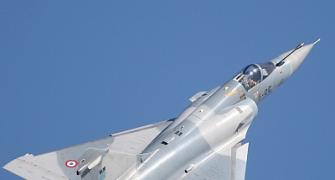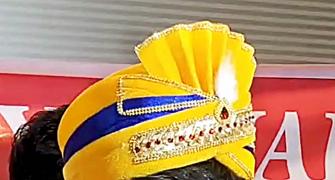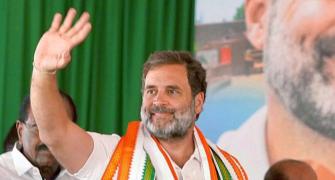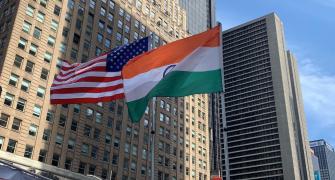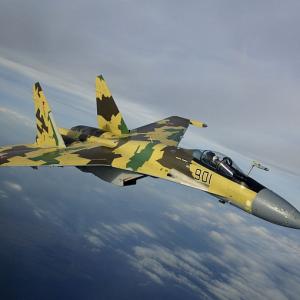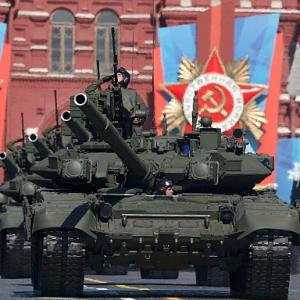The IAF chief stressed on the ongoing development of advanced landing ground along the Himalayas. Ajai Shukla reports

Indian Air Force boss, Air Chief Marshal Arup Raha, has confirmed that the force was ordering 120 (six squadrons) Tejas Mark I Light Combat Aircraft, triple the 40 aircraft it had previously committed to buying from Hindustan Aeronautics Limited.
Addressing a press conference in New Delhi on Saturday, in the lead up to Air Force Day on October 8, Raha declared, "We are ready to take more -- 120 (fighters), six squadrons of Tejas... We are ready to take it as soon as they can provide it. That means they have to ramp up the production rate, which is running behind schedule... But we will take all 120."
Raha endorsed Business Standard's description of the configuration of the additional fighters, which is being dubbed the Tejas Mark 1A.
It will have an under-wing pod for electronic warfare and jamming, aerial refuelling capability, better air-to-air missiles and rearranged internals for easy maintenance.
For More Defence Stories, Click HERE
Unlike former air force chiefs who have often used Air Force Day to paint a dire picture of a weakening air force with dwindling aircraft numbers, an optimistic Raha predicted, "We are looking forward to building up our combat fleet to 42 squadrons by the end of the 14 th plan, by 2027. I think it is possible, it is viable, there are a lot of options available with us, and discussions are already on."
Raha's optimism rests on his acceptance of indigenisation, a notable turnaround from his predecessors, who never planned beyond one-to-two Tejas squadrons. Raha's acceptance of six Tejas squadrons immediately makes the numbers better.
Furthermore, he is optimistic about the next-generation advanced medium combat aircraft that the Defence R&D Organisation has begun designing in close partnership with the IAF.
Raha sees the AMCA, which he says will take 15 years of development and prototype testing, as the IAF's future, along with the fifth-generation fighter aircraft that Russia and India plan to co-develop.
The AMCA would come into service around 2030, just in time to replace three types of IAF combat aircraft whose service lives are currently being extended through avionics upgrades (MiG-29 and Mirage 2000), and an engine replacement programme (Jaguar).
Raha signalled growing IAF disenchantment with the FGFA, something that has been increasingly evident from the inability of New Delhi and Moscow to agree on an R&D contract.
The air chief confessed, "There are some issues which have cropped up in terms of the work share, in terms of the present technological and technical aspects of the PAK-FA (the Russian FGFA prototype, which is undergoing test flights), and of course the cost visibility. So these are the issues we are looking at and they have been taken up at the highest level."
However, the air chief believes that the AMCA's promise compensates for uncertainty over the FGFA.
Says Raha, "If the FGFA comes through it is fine, otherwise the Indian FGFA -- that is the AMCA, the advanced medium combat aircraft -- we still have over 15 years to work on it before the MiG-29 upgraded aircraft retire, before the Mirage 2000 upgraded ones retire, as well as Jaguar upgraded ones retire in another 15 years."
In contrast to its aloofness from the Tejas programme, the IAF has immersed itself in the AMCA programme, to the DRDO's pleasant surprise.
Raha enthuses, "I am very sure, if we put our hearts and souls together, and if the air force, the DRDO, the Aeronautical Development Agency and HAL and other agencies involved take joint responsibility, joint accountability and joint ownership, [AMCA] is highly possible."
Notwithstanding Raha's embrace of indigenisation, he retains the IAF's conviction that it is essential to have at least six squadrons of the Rafale.
Interestingly, he leaves the door open for any other medium multi-role combat aircraft.
"I cannot give you numbers, but definitely we would like to have the MMRCA type of aircraft, at least six squadrons to my mind. But let's see, there may be some other alternatives as well," he said.
The IAF chief stressed on the on-going development of advanced landing ground along the Himalayan frontiers, especially in Jammu & Kashmir and the north-east. He said Nyoma and Kargil airports in Ladakh are important, "Not only for capability enhancement of the air force in support of the army, it is also going to help us in increased tourist traffic and economic development."
Indicating that Kargil would be developed as a tourist hub, Raha said the IAF would "extend the runway not only so that it can be used by larger bodied aircraft of the air force, or combat aircraft, but also larger-bodied (civil) aircraft..."
In contrast, Nyoma, which is being developed as a fighter-capable airfield in remote Southern Ladakh, at an altitude of over 13,000 feet, would take longer, because of its hostile climate and short working seasons.
"So even if we can start the work this year, it will take several working seasons, to my mind between three and five to complete the work."


